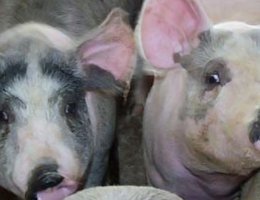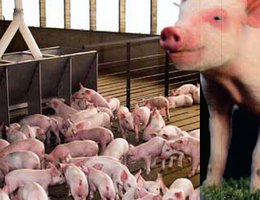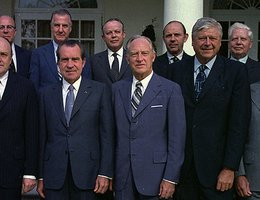

You may think names such as Quality Pig, Inc., Profit Pig, Inc., Pork Chop, Inc., and Oink, Inc. are names given to corporate hog factories by their critics. But, the names were no laughing matter to Nebraska’s pork industry, which ibecame increasingly dominated by large-scale confinement hog factories in the latter part of the twentieth century.
Good hog prices, lucrative tax breaks, and in some cases, government financing brought a flurry of non-farmer investments in Nebraska hog confinement facilities prior to the passage of Initiative 300. Insurance companies, out-of-state investors, corporate farmers, and even cattle feeders all jumped on the bandwagon to invest in large hog confinement operations.
In 1979, about 20% of the sows farrowed (or born) in Nebraska were housed in factory-like confinement units managed by hired managers. The Center for Rural Affairs’ report on the "corporate sow" (1974) indicated that the movement of feeder pig production from the farm to the factory could be completed in the very near future. Just four years after that report was released, Nebraska’s pig crop farrowed in hog factories tripled from 7% in 1974 to 24% in 1978.
While many of the hog factories were owned by farmers in the late 1970s and early 1980s, more and more were owned by non-farm investors and corporations. The growing number of investors included everyone from grocers to insurance agents to bankers to drywall contractors.
Critics said the high-cost technology made involvement in agriculture and industry an opportunity only for those few who had wealth. Critics also charged that the U.S. government paid people through tax savings to invest in hog confinement, and the higher the investor’s income, the more that investor received. They said there were also accounting rules that gave favorable treatment to big farmers and to people in high income tax brackets.

Opponents of factory farms controlled by corporations added that these tax savings were really just government subsidies to the investor and a major factor in the boom in factory confinement hog production. The tools of the tax-subsidized investor included tax breaks, which were technically available to everyone, but most beneficial to big farmers and high income bracket taxpayers. Investment credit and accelerated depreciation basically benefited high-income bracket taxpayers and primarily benefited purchasers of large amounts of expensive large-scale, labor saving equipment. It gave them a competitive edge over smaller farmers using less expensive and less subsidized equipment. In addition, favorable small business corporation tax rules benefited only corporate investors. Investment credit and limited liability provisions were especially attractive to corporate investors.
In 1980, there were 80% fewer U.S. hog producers than there were in 1950. It was projected that the most rapid growth would be in units marketing 2,000 or more hogs per year. It was anticipated that there would be almost complete use of factory production facilities. The projection was that fewer than 25% of the total number of hogs marketed in 2000 will be marketed by small-scale hog producers. A report in 2007 stated that large-scale hog producers made up almost 80% of the market in 2004. ("The Changing Economics of U.S. Hog Production", Economic Research Report, Number 52, U.S. Department of Agriculture, December 2007.)
Critics argued that federal tax subsidies, pollution control regulations, credit requirements, and Federal research programs were pushing hog production into the hands of a few. The United States Department of Agriculture (USDA) countered that hog factories are more efficient than small-scale producers. Former Secretary of Agriculture, Earl Butz, once told farmers to "get big or get out."

The shift to factory hog production may bring an end to the attractiveness of farrowing on the family farm. Although these large-scale units produce no more efficiently than smaller operations, their tax subsidies allow them to keep producing at prices unacceptable to less-subsidized small farmers.
Critics wondered who will sit up with the corporate sow when it gets sick? Will managers and hired hands in hog factories show the same dedication to raising hogs that is true of family-owned hog operations? Will managers and laborers who are paid a salary and who have no ownership of the product (hogs) work the irregular hours that are necessary when sows give birth to their baby pigs?
Family-owned hog operations experienced many of the problems the family-owned cattle feeding operations and small to middle size farmers face from corporation competition. Many family-owned hog operations saw Initiative 300 as a lifeline that was thrown to them to keep them from drowning in a sea of corporate hog factories.
Only time will tell if Initiative 300 has worked its magic or merely added to the farm crisis.